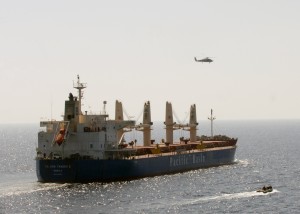 Blockading China is hard. Yes, China depends upon oil. Yes, China ships that oil from the Mideast, and yes, America has the biggest, baddest submarines and Navy in the business.
Blockading China is hard. Yes, China depends upon oil. Yes, China ships that oil from the Mideast, and yes, America has the biggest, baddest submarines and Navy in the business.
But advocates for blockade seem to have forgotten that times have changed, and a blockade–particularly on petrochemicals–run from an old “subs sink everything” World War II playbook, is ill-suited for the task at hand. But that doesn’t stop a constant cavalcade of “experts” from gleefully pointing out the obvious supply-chain vulnerabilities and suggesting that a blockade is an achievable thing. Here’s a bit from Jason Glab’s recent warontherocks.com piece, “Blockading China: A Guide“:
“…oil is China’s Achilles’ heel. Chinese domestic oil production supplies only 40% of peacetime consumption and demand continues to increase, even during periods of zero or negative growth in exports (see 2001 and 2009). Another advantage of targeting oil is the ease of discrimination. An oil tanker is a unique vessel, easing the blockaders’ burden when identifying and prioritizing targets. Significant smuggling of oil in other types of ships is impractical…”
That’s fine. But then, after a bunch of hand-waving and discussions of maritime chokepoints, Indonesia, VBSS teams and oil-tanker pre-certification and so forth, we get to the nitty-gritty, which is when we start sinking vessels. Here’s Glab:
“…This portion of the blockade would consist of submarines, mine warfare, and long range aircraft that would attack blockade runners that slipped through or around the chokepoints and entered a Maritime Exclusion Zone (MEZ) defined by the coalition. The MEZ would not need to be 100% impregnable, but a sufficient volume of traffic would need to be sunk to create a deterrent effect on potential blockade runners.”
Look. We loose the moment oil tankers start sinking.
In World War II, tankers were tiny, carrying less than 1/10th of an average tanker in service today. Sinking a single modern tanker is an environmental disaster. And blockade advocates seem to always forget basic complications–like the fact that environmental catastrophes have political consequences–and in Asia, where over 26% of the population rely on fish as their primary source of animal protein, fisheries fouled by oil slicks will have a far more immediate political impact than the gradual strangulation of China’s petroleum supply.
That’s why we need to be a little bit more nuanced in our approach to Anti-Resource/Resource-Denial (AR/RD) tactics. (Heck, in the event of a major “blockade-instigating” dispute with China, our VBSS teams would be overwhelmed just checking suspect traffic heading into our ports, let alone manning a set of maritime chokepoints…and hey, how many torpedoes do we have in the inventory, anyway?)
There are plenty of ways to disrupt the flow of critical resources into a country like China. But there are no easy answers, and what ones that we have are likely classified.
In the meantime, a constant drumbeat of over-optimistic affirmations of old-school strangulation theory risk leading the United States into miscalculation. From 20,000 feet, a blockade is a simple concept, and it appeals to those here in the US who might be inclined to action against China. But a blockade in practice is far more complicated, and the Navy must do what it can to deflate the rose-tinted expectations of policymakers and other geo-political tastemakers.
Old-school strategy from World War II is a poor fit for today’s modern battlefield. Any modern-day China-blockade advocates who say otherwise are just perpetuating irresponsible, oversimplified hype. It’s a type of tired rhetorical traffic well worth blockading.

{ 2 comments… read them below or add one }
The technical and market changes in the way the world handles crude oil makes the commodity very hard to bottle up. That’s the point–make a global market, move the commodity in bulk and so forth–the market itself is resilient, making it hard to control.
That’s why I am concerned about the blockade guys–they refuse to acknowledge that far more subtle (and possibly a few more provocative) things may be required to choke a country off from its oil…
There are a number of complications to be dealt with.
You can’t sink everything entering the South China Sea because allies and neutrals also need to have ships ply those waters. We will have to identify destinations for all the traffic entering the South China Sea.
Much of the South China Sea is shallow. Not a good place for SSNs.
Oil Tankers are very tough ships. Based on experience in during the tanker wars it takes several missiles to severely damage, much less sink a large merchant. There is a good chance it will take more than a single Mk-48 to sink a super tanker. Yes Mk-48s are awesome weapons against warships, but large tankers are much larger and well compartmented. Consider the damage survived by the relatively small, 9,264 ton SS Ohio http://en.wikipedia.org/wiki/SS_Ohio
T. X. Hammes’ Offshore Control (OC) Strategy only advocates stopping Post-Panamax traffic, but with their tremendous accumulated cash surpluses China can live and fight a long time if we don’t also cut their trade carried on smaller ships.
I suspect we will need more ships than we have to impose a blockade and do all the required boardings.
The LCS are the most likely surface vessels to be doing VBSS to enforce a blockade, but they are not currently equipped to forcibly stop a medium to large merchant ship. When we do find a recalcitrant Chinese controlled merchantman, the small torpedoes we talked about earlier might come in handy as a way to stop a vessel without creating an environmental disaster.